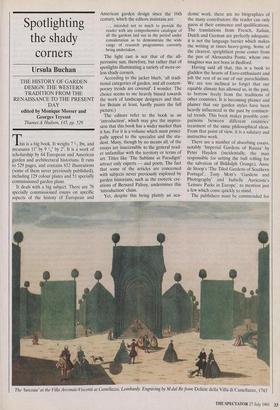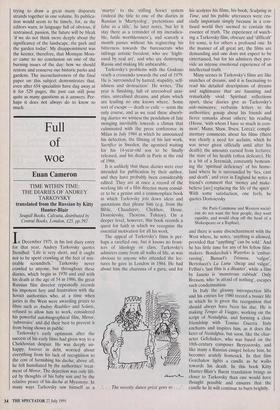Spotlighting the shady corners
Ursula Buchan
THE HISTORY OF GARDEN DESIGN: THE WESTERN TRADITION FROM THE RENAISSANCE TO THE PRESENT DAY edited by Monique Mosser and Georges Teyssot Thames & Hudson, f45, pp. 529 This is a big book. It weighs 7 1/2 lbs, and measures 11" by 9 3/4" by 2". It is a work of scholarship by 64 European and American garden and architectural historians. It runs to 529 pages, and contains 652 illustrations (some of them never previously published), including 129 colour plates and 51 specially commissioned garden plans.
It deals with a big subject. There are 76 specially commissioned essays on specific aspects of the history of European and American garden design since the 16th century, which the editors maintain are
... intended not so much to provide the reader with any comprehensive catalogue of all the gardens laid out in the period under consideration as to demonstrate the wide range of research programmes currently being undertaken.
The light cast is not that of the all- pervasive sun, therefore, but rather that of spotlights illuminating a variety of more-or- less shady corners.
According to the jacket blurb, 'all tradi- tional categories of garden, and all contem- porary trends are covered'. I wonder. The choice seems to me heavily biased towards the work of landscape designers and that, for Britain at least, hardly paints the full picture.)
The editors refer to the book as an `introduction', which may give the impres- sion that this book has a wider market than it has. For it is a volume which must princi- pally appeal to the specialist and the stu- dent. Many, though by no means all, of the essays are inaccessible to the general read- er unfamiliar with the territory or terms of art. Titles like The Sublime as Paradigm' attract only experts — and poets. The fact that some of the articles are concerned with subjects never previously explored by garden historians, such as the esoteric cre- ations of Bernard Palissy, undermines this `introduction' claim.
Yet, despite this being plainly an aca- demic work, there are no biographies of the many contributors: the reader can only guess at their eminence and qualifications. The translations from French, Italian, Dutch and German are perfectly adequate; it is not the language barrier which makes the writing at times heavy-going. Some of the clearest, sprightliest prose comes from the pen of Alessandra Ponte, whom one imagines was not born in Bedford.
Having said all that, this is a book to gladden the hearts of Euro-enthusiasts and jolt the rest of us out of our parochialism. We are too inclined to forget that our equable climate has allowed us, in the past, to borrow freely from the traditions of other countries. It is becoming plainer and plainer that our garden styles have been heavily influenced in the past by continen- tal trends. This book makes possible com- parisons between different countries' treatment of the same philosophical ideas. From that point of view, it is a salutary and instructive work.
There are a number of absorbing essays, notably 'Imperial Gardens of Russia' by Peter Hayden (incidentally, the man responsible for setting the ball rolling for the salvation of Biddulph Grange), Anne de Stoop's 'The Tiled Gardens of Southern Portugal', Tony Mott's 'Gardens and Photography' and Isabelle Auricoste's `Leisure Parks in Europe', to mention just a few which come quickly to mind.
The publishers must be commended for The `berceatt' at the Villa Arconati-Visconti at Castellazzo, Lombardy. Engraving by M.dal Re from Dclizie della Villa di Castellazzo, 1743 trying to draw a great many disparate strands together in one volume. Its publica- tion would seem to be timely, for, as the editors warn, in language full of obvious, if restrained, passion, the future will be bleak `if we do not think more deeply about the significance of the landscape, the park and the garden today'. My disappointment was the keener, therefore, that Monique Moss- er came to no conclusion on one of the burning issues of the day: how we should restore and conserve our historic parks and gardens. The inconclusiveness of the final paper on this subject demonstrates that, even after 654 specialists have dug away at it for 529 pages, the past can still pose quite as many questions as it answers. Per- haps it does not always do to know so much.



















































 Previous page
Previous page